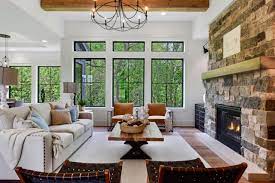
The importance of our surrounding environment on our mental well-being is often overlooked. When it comes to bettering mental health, therapy, medication, diet, and exercise usually take precedence. However, the place where we live—the colors, the light, the layout, the decor—plays a crucial role in shaping our mental states.
As someone who has struggled with mental health issues, I embarked on a journey to design my home to be not just a living space, but a sanctuary for my mind. Here’s how I did it.
Anchored in Personal Identity
One's home should reflect who they are. The first step towards making my home a nurturing environment was aligning the design with my unique personality. As a lover of nature and tranquility, I sought to create an environment that would mirror my peaceful aspirations. This also meant eliminating elements that caused stress or negativity, like clutter or stark colors.
The Power of Natural Light
The importance of natural light cannot be overstated for mental well-being. Light regulates our circadian rhythm and serotonin levels, both of which directly influence our mood and sleep patterns. Hence, I prioritized maximizing the entry of natural light. I replaced heavy drapes with translucent curtains, installed a larger window in my living room, and used mirrors strategically to reflect and amplify sunlight.
Color Psychology
Colors have a profound impact on our mood and behavior. I carefully chose a color palette for my home to enhance my mood positively. I leaned towards light, earthy tones like greens, blues, and beiges, which are known to evoke feelings of calmness and relaxation. Splashes of yellow and orange were added to stimulate creativity and enthusiasm.
Green Indoors
Plant life has a natural ability to create a calm and soothing environment. Adding indoor plants to my home was a decision driven by both aesthetic and health benefits. They don't just act as natural air purifiers but also provide a sense of purpose as you care for them. I introduced a range of houseplants like peace lilies, snake plants, and spider plants, each offering a distinct texture and character to the rooms.
Decluttering and Organization
Mess breeds stress. A cluttered space can induce feelings of anxiety and overwhelm, which is why I took measures to organize and declutter my home. I adopted the KonMari method, where I kept only things that "sparked joy". I ensured everything had a designated place, making the environment tidy, orderly, and harmonious.
Personal Spaces for Relaxation
Creating specific areas in the home for relaxation or engaging in enjoyable activities is a vital step in designing a mentally soothing environment. I converted a small corner of my living room into a meditation space with a yoga mat, candles, and calming artwork. I also set up a reading nook by the window, complete with comfortable seating, good lighting, and a shelf filled with my favorite books.
Sound and Smell
In addition to visual elements, I integrated pleasing sounds and scents into my home. I installed a small water feature that produces a soothing sound, simulating the ambiance of a serene outdoor space. For smell, I opted for essential oil diffusers with calming scents like lavender and chamomile.
Ergonomics and Comfort
Comfort is an integral part of mental well-being. Ergonomic furniture choices and layout can substantially affect our physical comfort and subsequently our mental health. I replaced stiff, uncomfortable seating with more ergonomic options and arranged my furniture to promote easy movement and accessibility.
Embracing Minimalism
In a world that relentlessly promotes consumerism, I found solace in minimalism. The minimalist design focuses on the essentials, creating spaces that are functional, clear, and devoid of distractions. This approach fostered a sense of simplicity and tranquility in my home.
Art and Personal Belongings
Finally, I adorned my home with art and personal belongings that sparked joy and invoked positive memories. A blend of family photos, travel souvenirs, and art that resonated with my aesthetic sense transformed my house into a home. They served as reminders of happy times and personal achievements, thereby fostering positivity.
The journey of designing my home for better mental health was one of introspection and creativity. It involved recognizing my needs and desires, understanding how different elements affect mood and emotions, and crafting spaces that would nourish my mental health. It proved that home is more than a shelter; it's a personal haven that can play a significant role in mental well-being.
Remember, everyone's mental health needs are different. What works for one person may not work for another. The goal is to create an environment that feels good to you, offers comfort, and helps you navigate the journey of life with a positive and peaceful mind.
To those looking to turn their living spaces into a sanctuary for mental health, I hope my experience serves as a helpful starting point. Start small, trust your instincts, and gradually, you can transform your house into a home that nurtures your mind and soul.

















